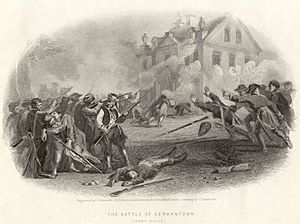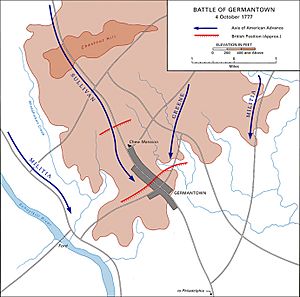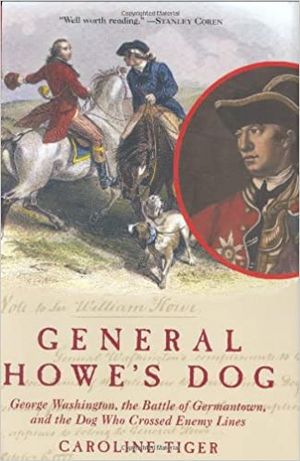Battle of Germantown facts for kids
Quick facts for kids Battle of Germantown |
|||||||
|---|---|---|---|---|---|---|---|
| Part of the American Revolutionary War | |||||||
 American forces lay siege to the Chew house during the Battle of Germantown. |
|||||||
|
|||||||
| Belligerents | |||||||
|
|
||||||
| Commanders and leaders | |||||||
| Strength | |||||||
| 9,000 | 11,000 | ||||||
| Casualties and losses | |||||||
| 71 killed 448 wounded 14 missing |
152 killed 521 wounded 438 captured |
||||||
The Battle of Germantown was an important fight during the American Revolutionary War. It happened on October 4, 1777, near Germantown, Pennsylvania. The British army won this battle. This victory meant that Philadelphia, which was the capital for the American revolutionaries, would stay under British control through the winter of 1777 and 1778.
Contents
Planning the Battle
The American forces, led by General George Washington, had a tough time in the Philadelphia campaign. They had lost battles at Brandywine and Paoli. This left Philadelphia open for the British to take.
On September 26, 1777, British General Charles Cornwallis occupied Philadelphia. General William Howe, the British commander, left 3,000 soldiers in Philadelphia. He then moved 9,000 men to Germantown, which was about five miles north of the city. General Howe wanted to find and defeat Washington's army. He set up his main camp at a large house called Stenton.
General Washington decided to attack the British in Germantown. He wanted to do this before winter arrived. His plan was to attack the British from four different directions at the same time. He hoped to surprise them, just like he had surprised the Hessians at the Battle of Trenton.
Where the Armies Were
Germantown was a small town with stone houses. It stretched from what is now Mount Airy in the north to Wayne Junction in the south. General Howe's camp was on high ground near Schoolhouse and Church lanes.
The western part of the British camp was led by the Hessian General Wilhelm von Knyphausen. Hessians were German soldiers who fought for the British. They had soldiers called Jägers guarding their left side. Other British and Hessian soldiers were camped near Market Square. To the east, General James Grant commanded two British brigades. The Queen's Rangers, a group of American colonists loyal to Britain, protected the far right side.
The Americans March Out
The American army left their camp just after dark on October 3, 1777. The British and Hessian soldiers did not know that Washington's troops were coming. The Americans hoped to repeat their success from the Battle of Trenton.
However, the night made it hard for the different American groups to communicate. They also moved slower than planned. By dawn, the American army was not yet in position. This meant they lost the element of surprise.
One group of American militia did reach the British camp. They fired some cannon shots at Knyphausen's camp before leaving. The main American attack was divided into three more groups:
- One group, led by General John Sullivan, marched along Germantown Road.
- Another group of New Jersey militia, led by General William Smallwood, moved along Skippack Road. They planned to attack the British right side.
- The third group, led by General Nathanael Greene, marched along Limekiln Road. They aimed to attack the main British camp.
The Battle Begins
The battle started around 5 AM as the sun was rising. General Sullivan's lead soldiers fired at the British guards at Mount Airy. A very thick fog covered the battlefield all day, making it hard to see. The British guards fought back strongly. They fired their guns to warn the main army about the attack. General Howe rode forward, thinking it was just a small skirmish.
It took many of Sullivan's soldiers to finally push back the British guards. These British soldiers, led by Colonel Musgrave, were now cut off from their main army. About 120 of them took shelter in a strong stone house called Cliveden. This house belonged to Chief Justice Chew.
The American forces attacked Cliveden fiercely. But the small group of defenders fought them off, causing many American casualties. General Washington held a meeting with his officers. Some wanted to go around the Chew House and leave a small group to deal with it. However, General Henry Knox, Washington's artillery commander, advised against it. He said they should not leave an enemy group behind them as they advanced. Washington agreed.
General William Maxwell's soldiers, who were held in reserve, were sent to attack the Chew mansion. Knox placed four cannons out of musket range and fired at the house. But the thick stone walls of Cliveden were too strong. American soldiers who tried to storm the house were shot or stabbed. It became clear that the Chew House would not be easy to capture. The American attack was starting to slow down.
Meanwhile, General Nathanael Greene's group on Limekiln Road caught up with the American forces. His lead soldiers fought with British guards at Luken's Mill and pushed them away. The thick fog, combined with smoke from cannons and muskets, made it very confusing. Greene's group became disorganized.
One of Greene's brigades, led by General Stephen, went off course. They started following Meetinghouse Road instead of joining Greene's main force. This lost brigade accidentally ran into General Wayne's American soldiers. They mistook Wayne's men for British soldiers. The two American groups fired heavily at each other. They became very confused and ran away. Wayne's soldiers retreating left another American group, Conway's, without support.
In the north, an American group led by McDougall was attacked by the Queen's Rangers and British Guards. After a tough fight, McDougall's soldiers had to retreat, losing many men.
Still, some American soldiers, the 9th Virginian troops from Greene's group, bravely attacked the British and Hessian line. They broke through and captured some prisoners. But they were soon surrounded by two British brigades. General Cornwallis led a strong counterattack. Completely cut off, the 9th Virginian Regiment had to surrender. When Greene learned that the main American army was retreating, he realized he was alone against the British and Hessians. So, he also pulled back his troops.
The main American attacks on the British and Hessian camp had failed. They had suffered many losses. Washington ordered Armstrong's and Smallwood's men to retreat. Maxwell's soldiers, who had not captured the Chew House, also had to fall back. Part of the British army chased the retreating Americans for about nine miles. They finally gave up the chase when Greene's soldiers, Wayne's cannons, and some dragoons fought back. Nightfall also helped the Americans escape.
What Happened After
Out of 11,000 American soldiers, 152 were killed and 521 were wounded. Over 400 were captured, including an entire regiment. General Francis Nash was badly wounded and died a few days later. 57 Americans died just trying to attack the Chew House.
The British had 70 killed and 450 wounded. British officers who died included General James Agnew.
The battle was a victory for the British and Hessians. They stopped the Americans from taking Germantown and possibly Philadelphia.
Washington's plan failed for several reasons:
- Washington thought his soldiers were better trained for such a complex attack.
- The plan needed constant communication between the different groups, which did not happen.
- When the British soldiers at the Chew House fought back, General Stephen disobeyed orders and tried to attack the house, wasting time and lives.
However, the British did not chase the retreating Americans very far. Even though it was a loss, the Battle of Germantown had a good long-term effect for the Americans. The French, who were watching the war closely, were impressed that Washington was willing to launch such a big attack. They saw that the Americans were truly determined to win the war. This encouraged France to help the Americans more, which was a big step towards American independence.
General Howe's Dog
Two days after the battle, on October 6, there was a short break in fighting.
A small Fox Terrier dog was found wandering on the battlefield. Its collar showed it belonged to General Howe. The dog, named Lila, was brought to George Washington. Washington made sure the dog was fed, cleaned, and brushed. Then, he sent the dog back to General Howe under a special agreement called a "flag of truce."
Author Caroline Tiger wrote a book about this interesting event in 2005.
Images for kids
-
Cliveden is a National Historic Landmark.
See also
 In Spanish: Batalla de Germantown para niños
In Spanish: Batalla de Germantown para niños






